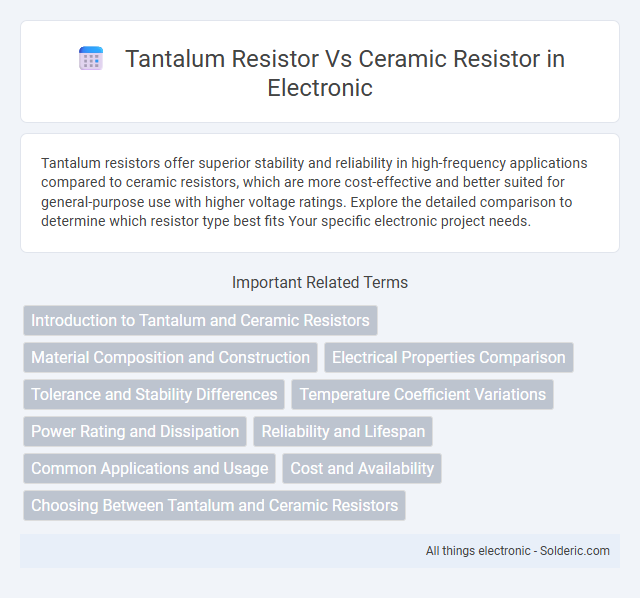Tantalum resistors offer superior stability and reliability in high-frequency applications compared to ceramic resistors, which are more cost-effective and better suited for general-purpose use with higher voltage ratings. Explore the detailed comparison to determine which resistor type best fits Your specific electronic project needs.
Comparison Table
| Feature | Tantalum Resistor | Ceramic Resistor |
|---|---|---|
| Material | Tantalum metal oxide | Ceramic composite |
| Resistance Range | Low to medium resistance values | Wide range, from low to high values |
| Tolerance | Typically +-1% to +-5% | +-5% to +-10%, precision versions +-1% |
| Power Rating | Low power, typically up to 0.5W | Higher power, up to several watts |
| Temperature Coefficient | Better stability, low TCR | Varies, generally higher TCR |
| Applications | Precision circuits, low noise, audio circuits | General purpose, power dissipation, high stability |
| Cost | Higher cost due to material | Lower cost, widely available |
| Size | Compact | Varied sizes, usually larger |
Introduction to Tantalum and Ceramic Resistors
Tantalum resistors offer excellent stability and reliability in harsh environments, making them ideal for precision electronics and high-temperature applications. Ceramic resistors provide robust performance with high power dissipation and thermal endurance, commonly used in general-purpose circuits requiring durability. Understanding these materials helps optimize Your electronic designs by selecting the right resistor type for specific electrical and environmental demands.
Material Composition and Construction
Tantalum resistors are made from tantalum metal powders pressed into a solid pellet and coated with a resistive film, offering high stability and performance in demanding applications. Ceramic resistors utilize ceramic materials as an insulating base with a thick or thin film resistive layer applied on top, providing excellent heat dissipation and mechanical strength. Your choice depends on whether you need the higher precision and reliability of tantalum or the robust thermal and mechanical properties of ceramic resistors.
Electrical Properties Comparison
Tantalum resistors offer superior stability and lower noise levels compared to ceramic resistors due to their dense, conductive oxide layer, making them ideal for precision applications requiring consistent resistance over time. Ceramic resistors, however, provide higher power ratings and better heat dissipation, suitable for environments with significant thermal stress but may exhibit greater variance in resistance values under temperature changes. Your choice between tantalum and ceramic resistors should consider the specific electrical performance needs, including tolerance, temperature coefficient, and noise sensitivity.
Tolerance and Stability Differences
Tantalum resistors typically offer tighter tolerance ranges, often as low as +-1%, compared to ceramic resistors which commonly exhibit wider tolerances around +-5%. In terms of stability, tantalum resistors demonstrate superior performance with lower temperature coefficients and enhanced resistance to environmental factors such as humidity and mechanical stress. Ceramic resistors tend to experience greater drift and variability over time, making tantalum resistors preferable for precision applications.
Temperature Coefficient Variations
Tantalum resistors exhibit a lower temperature coefficient variation, typically around +-50 ppm/degC, enabling more stable resistance under temperature changes compared to ceramic resistors, which can have coefficients ranging from +-100 ppm/degC to +-200 ppm/degC. This characteristic makes tantalum resistors preferable for precision applications requiring consistent performance across varying thermal conditions. Your choice between these resistors will impact the accuracy and reliability of temperature-sensitive circuits.
Power Rating and Dissipation
Tantalum resistors typically offer higher power ratings and better dissipation capabilities compared to ceramic resistors, making them suitable for applications requiring efficient thermal management. Ceramic resistors often have lower power ratings due to their material properties but provide excellent stability and tolerance under varying environmental conditions. Your choice between these resistors should consider the power dissipation requirements and thermal stress of your specific circuit design.
Reliability and Lifespan
Tantalum resistors offer superior reliability due to their stable electrical characteristics and resistance to high-temperature environments, making them ideal for applications requiring long-term performance. Ceramic resistors exhibit excellent lifespan in harsh conditions thanks to their robust construction and high tolerance to mechanical stress and thermal shock. When comparing lifespan, tantalum resistors typically outperform ceramic resistors in precision and moisture resistance, while ceramics excel in rugged durability under physical and environmental strain.
Common Applications and Usage
Tantalum resistors are commonly used in high-frequency circuits and precision applications due to their stability and low noise characteristics, making them ideal for military and aerospace electronics. Ceramic resistors are preferred for power dissipation and high-voltage applications, found frequently in automotive electronics, industrial equipment, and household appliances. Both resistor types are essential for specific operational environments, with tantalum resistors excelling in miniature and high-reliability circuits while ceramic resistors provide robustness and thermal stability in demanding conditions.
Cost and Availability
Tantalum resistors generally have higher costs due to the rarity and expense of tantalum materials, making them less available compared to ceramic resistors. Ceramic resistors are widely manufactured with abundant raw materials, resulting in lower prices and broad availability across various suppliers. The cost-effectiveness and easy accessibility of ceramic resistors make them the preferred choice for mass production and standard electronic applications.
Choosing Between Tantalum and Ceramic Resistors
Choosing between tantalum and ceramic resistors depends on your application's requirements for stability, tolerance, and temperature performance. Tantalum resistors offer high stability and low noise, ideal for precision circuits, while ceramic resistors excel in handling high power and heat dissipation with good mechanical strength. Evaluating your device's operating conditions and performance needs ensures selecting the optimal resistor type for durability and efficiency.
Tantalum resistor vs ceramic resistor Infographic

 solderic.com
solderic.com